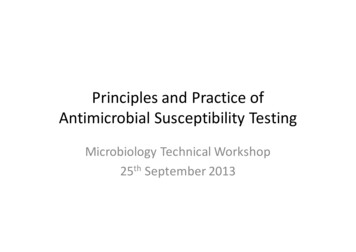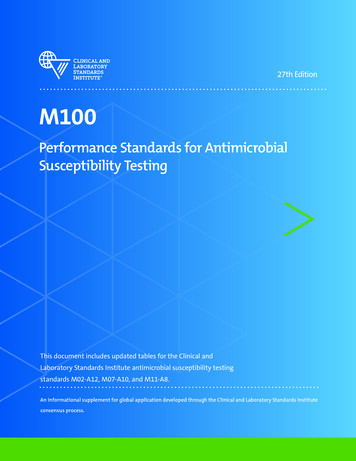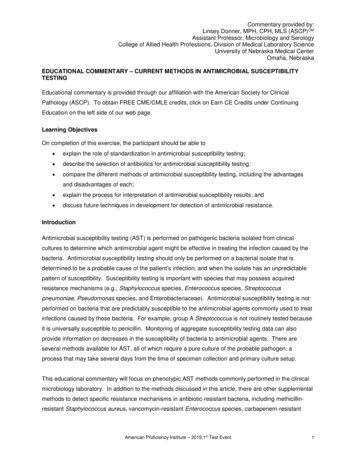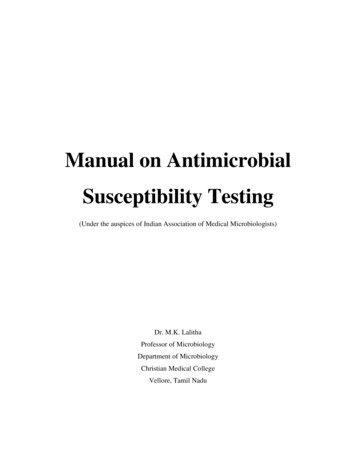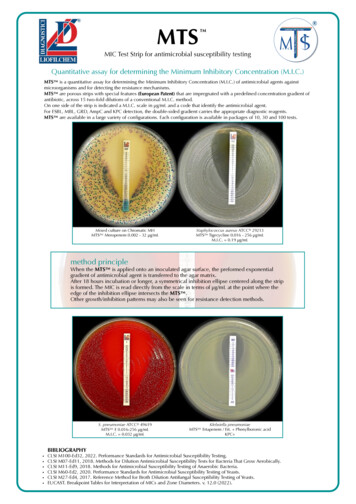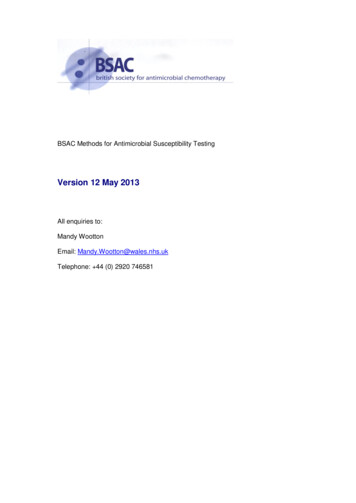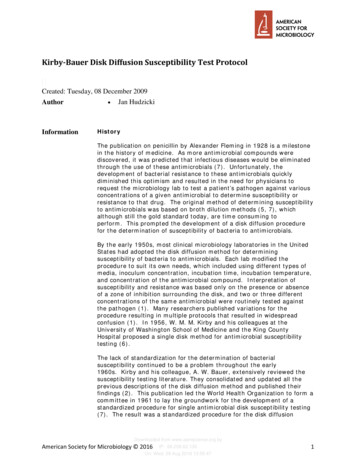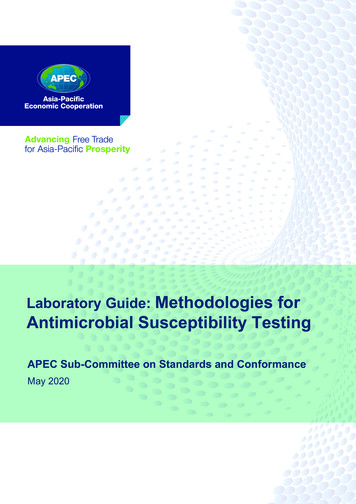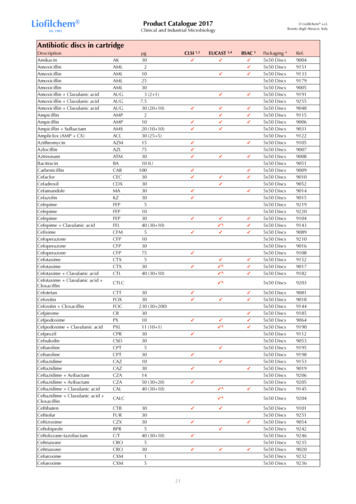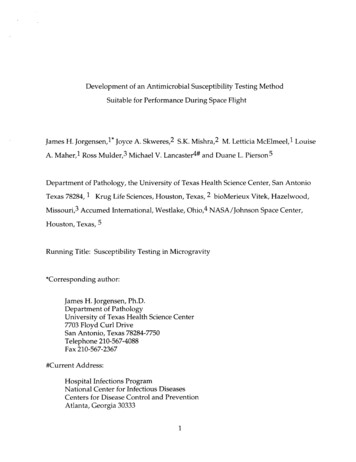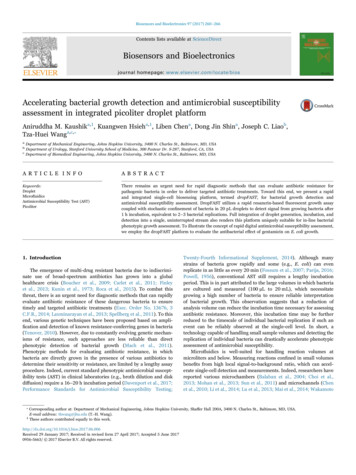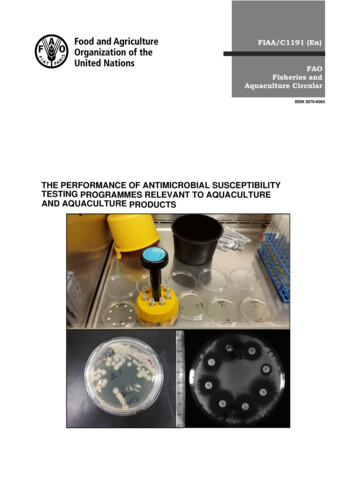
Transcription
FIAA/C1191 (En)FAOFisheries andAquaculture CircularISSN 2070-6065THE PERFORMANCE OF ANTIMICROBIAL SUSCEPTIBILITYTESTING PROGRAMMES RELEVANT TO AQUACULTUREAND AQUACULTURE PRODUCTS
Photographs captions and credits:Top: BD BBL Sensi-Disc Stamp Dispenser used for antimicrobial susceptibility testing. Photo credit: FAO/O.Elhassan.Bottom left: Escherichia coli culturing and isolation on tryptic soy agar (TSA) plates. Photo credit: FAO/O. Elhassan.Bottom right: Escherichia coli lawn stamped with susceptibility discs, showing resistance to ampicillin andintermediate resistance to tetracycline. Photo credit: FAO/O. Elhassan.
FAO Fisheries and Aquaculture Circular No. 1191FIAA/C1191 (En)THE PERFORMANCE OF ANTIMICROBIAL SUSCEPTIBILITYTESTING PROGRAMMES RELEVANT TO AQUACULTUREAND AQUACULTURE PRODUCTSbyPeter SmithDepartment of MicrobiologyNational University of Ireland, GalwayGalway, IrelandFOOD AND AGRICULTURE ORGANIZATION OF THE UNITED NATIONSRome, 2019
Required citation:Smith, P. 2019. The performance of antimicrobial susceptibility testing programmes relevant to aquaculture and aquaculture products.FAO Fisheries and Aquaculture Circular No. 1191. Rome, FAO.The designations employed and the presentation of material in this information product do not imply the expression of any opinionwhatsoever on the part of the Food and Agriculture Organization of the United Nations (FAO) concerning the legal or development status ofany country, territory, city or area or of its authorities, or concerning the delimitation of its frontiers or boundaries. The mention of specificcompanies or products of manufacturers, whether or not these have been patented, does not imply that these have been endorsed orrecommended by FAO in preference to others of a similar nature that are not mentioned.The views expressed in this information product are those of the author(s) and do not necessarily reflect the views or policies of FAO.ISBN 978-92-5-131788-4 FAO, 2019Some rights reserved. This work is made available under the Creative Commons Attribution-NonCommercial-ShareAlike 3.0 IGO licence(CC BY-NC-SA 3.0 IGO; igo/legalcode).Under the terms of this licence, this work may be copied, redistributed and adapted for non-commercial purposes, provided that the work isappropriately cited. In any use of this work, there should be no suggestion that FAO endorses any specific organization, products or services.The use of the FAO logo is not permitted. If the work is adapted, then it must be licensed under the same or equivalent Creative Commonslicence. If a translation of this work is created, it must include the following disclaimer along with the required citation: “This translationwas not created by the Food and Agriculture Organization of the United Nations (FAO). FAO is not responsible for the content or accuracyof this translation. The original [Language] edition shall be the authoritative edition.”Disputes arising under the licence that cannot be settled amicably will be resolved by mediation and arbitration as described in Article 8 ofthe licence except as otherwise provided herein. The applicable mediation rules will be the mediation rules of the World IntellectualProperty Organization http://www.wipo.int/amc/en/mediation/rules and any arbitration will be conducted in accordance with the ArbitrationRules of the United Nations Commission on International Trade Law (UNCITRAL).Third-party materials. Users wishing to reuse material from this work that is attributed to a third party, such as tables, figures or images,are responsible for determining whether permission is needed for that reuse and for obtaining permission from the copyright holder. The riskof claims resulting from infringement of any third-party-owned component in the work rests solely with the user.Sales, rights and licensing. FAO information products are available on the FAO website (www.fao.org/publications) and can be purchasedthrough publications-sales@fao.org. Requests for commercial use should be submitted via: www.fao.org/contact-us/licence-request. Queriesregarding rights and licensing should be submitted to: copyright@fao.org
iiiPREPARATION OF THIS DOCUMENTAn initial draft of this paper was produced as a discussion document for a series of regionalworkshops organized by FAO under the project FAO FMM/RAS/298: Strengtheningcapacities, policies and national action plans on prudent and responsible use of antimicrobialsin fisheries.The general comment received was that this will be a quite useful document that will providegood guidance to countries with respect to standard susceptibility testing protocols, the qualitycontrol requirements and the respective interpretive criteria for bacteria isolated from aquaticanimals. It is also considered timely with the current attention given to antimicrobial resistance(AMR).This was prepared under the auspices of FAO’s Strategic Programme 4: Enable more inclusiveand efficient agricultural and food systems and specifically 4.1.1: Public sector institutions aresupported to improve their capacity to design and implement better policies and regulatoryframeworks, and to provide public services related to plant and animal health, food safety andquality.
ivABSTRACTAntimicrobial susceptibility testing of bacteria isolated from aquatic animals and theirenvironments may be performed either as part of a monitoring or surveillance programme orto provide guidance for clinical treatments of diseased animals. This technical paper addressesbest practice guidelines for the performance of these susceptibility tests. Section 1 discussesthe relevance of this document to The FAO Action Plan on Antimicrobial Resistance 20162020. Section 2 provides a general background to the principles of antimicrobial susceptibilitytesting. It stresses the absolute need for the use of internationally agreed standardized testprotocols and the adherence to the quality control requirement of those protocols. It alsostresses the importance of the use of consensus-based, internationally harmonized criteria inthe interpretation of the meanings that can be given to in-vitro susceptibility data. It provides adiscussion of the theory of interpretive criteria and the methods by which they can becalculated. Section 3 discusses the current status of the standard protocols that can berecommended for use in antimicrobial susceptibility testing of bacteria isolated from aquaticanimals. Following a consideration of 44 species of bacteria that represent those mostfrequently isolated from aquatic animals, it demonstrates that the currently availablestandardized protocols are adequate for the determination of the antimicrobial susceptibility of37 of them (84 percent). Section 4 discusses the importance of the design of programmes aimedat monitoring or surveillance of antimicrobial resistance associated with the use ofantimicrobial agents in the rearing of aquatic animals. These programmes may be performedto address various questions. It is important that the design adopted in any programmegenerates data appropriate to the question being asked. In this paper four designs are outlined,each of which will provide data for programmes aimed at answering different questions.Section 5 provides some conclusions, while Section 6 gives a list of references. The technicalpaper is supported by four annexes that provide: (i) a listing of Clinical and LaboratoryStandards Institute (CLSI) documents cited in the paper; (ii) a list of the antimicrobial agentsmost commonly used in aquaculture; (iii) notes on the selection of test protocols for selectedGram-positive cocci; and (iv) guidance on the possible use of epidemiological cut-off valuesin a clinical context.
vCONTENTSPreparation of this document . iiiAbstract . ivAcknowledgements . viiAbbreviations and acronyms. viii1. Background . 12. General susceptibility condsiderations . 12.1. Introduction . 12.2. The use of internationally standardized susceptibility testing protocols . 22.3. Quality control . 32.4. Susceptibility testing methods . 42.4.1. Choice of MIC or disc methods . 42.4.2. Choice of agent concentrations to be used in MIC tests . 52.4.3. Choice of discs and disc contents to be used in disc diffusion tests . 52.5. Interpretive criteria. 62.5.1. Species specificity of interpretive criteria. 62.5.2. Protocol specificity of interpretive criteria . 62.5.3. Use of standardized terminology . 72.6. Clinical breakpoints . 72.7. Epidemiological cut-off values . 92.8. Setting interpretive criteria . 102.8.1. Setting new clinical breakpoints . 102.8.2. Setting new ECVs . 102.8.3. Epidemiological cut-off values for data produced in a single laboratory . 112.9. Precision of susceptibility test data and precision limits . 112.9.1. Measurement of MIC data set precision . 122.9.2. Precision limits of MIC data sets . 122.9.3. Precision limits of disc diffusion data sets . 133. Susceptibility testing protocols suitable for bacterialspecies isolated from aquatic animals . 133.1. Introduction . 133.2. Bacterial species. 143.3. Non-fastidious Gram-negative bacteria . 143.4. Halophilic Gram-negative bacteria (facultative and obligate halophiles) . 153.5. Flavobacteria and related species. 163.6. Gram-positive cocci . 173.7. Mycobacteria and related species . 203.8. Miscellaneous species . 214. The aims and design of studies to investigate antimicrobialagent susceptibility of bacteria isolated from aquatic animals . 214.1. Introduction . 214.2. Investigations of the susceptibility of pathogens of aquatic animals . 214.3. Investigations of the public health implications of the presence in aquaculturalproducts of bacteria with reduced susceptibility to antimicrobial agents . 23
vi4.4. Investigations of the public health implications of antimicrobial agent usein aquaculture mediated through aquacultural products . 244.5. Investigations of the public health implications of antimicrobial agent usein aquaculture mediated through the environmental resistome . 255. Conclusions . 256. References . 26Annex 1. CLSI documents cited in this Circular . 28Annex 2. Antimicrobial agents used in aquaculture . 29Annex 3. Notes on selection of test protocols for selected Gram-positive Cocci . 31Annex 4. On the Possible use of epidemiological cut-off values in a clinical context . 35TABLESTable 1.Table 2.Table 3.Table 4.Table 5.Precision limits for disc diffusion zone data sets . 13Availability of quality control (QC) data for susceptibility testsperformed on unmodified Mueller-Hinton agar (MHA) or cationadjusted Mueller-Hinton broth (CAMHB) with respect to the agentsmost commonly used in aquaculture . 15Availability of quality control (QC) data for minimum inhibitoryconcentration (MIC) susceptibility tests performed on diluteMueller-Hinton agar (MHA) or cation adjusted Mueller-Hintonbroth (CAMHB) with respect to the agents most commonlyused in aquaculture. 17Availability of quality control (QC) data for susceptibility testsperformed at 35 C with and without additions. . 19Availability of QC data for susceptibility tests performed at 28 Cwith and without additions . 20
viiACKNOWLEDGEMENTSThis document had been prepared under the coordination and technical supervision ofDr Melba B. Reantaso (Aquaculture Officer, Aquaculture Branch, FAO). Dr J. Richard Arthur(FAO consultant) provided technical comments and English grammar and technical editing.Mr Omar Elhassan, Ms Elena Irde, Ms Lisa Falcone and Ms Marianne Guyonnet, of theFisheries and Aquaculture Department (FI) of FAO, are gratefully acknowledged for theirassistance in the finalization of this document. The technical and operational support to thisinitiative provided by the staff and management of the FAO’s Fisheries and AquacultureDepartment and especially FIAA is sincerely appreciated.
viiiABBREVIATIONS AND ACRONYMSAMRCAMHBCLSICOwtECVEUCASTFAOG OWTAntimicrobial ResistanceCation adjusted Mueller-Hinton brothClinical and Laboratory Standards InstituteWild type cut-off valueEpidemiological cut-off valueEuropean Committee on Antimicrobial Susceptibility TestingFood and Agriculture Organization of the United NationsGram-positiveLysed horse bloodMultiple drug resistanceMueller-Hinton (media)Mueller-Hinton agarMinimum inhibitory concentrationNormalised resistance interpretationNon-wild typeWorld Organisation for Animal HealthPolymerase chain reactionPharmacokinetics and pharmacodynamicsQuality controlStandard deviationSensitive/intermediate/resistanceSheep red blood cellsTryptic soy agarWorld Health OrganizationWild type
11. BACKGROUNDIn 2016, the Food and Agriculture Organization of the United Nations (FAO) published TheFAO Action Plan on Antimicrobial Resistance 2016-2020 (FAO, 2016), which was designedto implement the resolution 4-2015 of the Thirty-ninth Session of the FAO Conference in June2015. Fundamental to this action plan was the “One Health” concept, that the health of humans,animals and the environment are interconnected. Therefore, with respect to antimicrobialresistances (AMR), the plan envisaged that there was a need to consider in a coordinatedmanner all areas where resistances might be selected, including those associated with the useof antimicrobial agents in humans, terrestrial animals and plants and aquatic animals. Inconjunction with the World Health Organization (WHO) and the World Organisation forAnimal Health (OIE), the plan proposed the development of capacity for the surveillance andmonitoring of antimicrobial resistance in all these areas.In Focus area 2, the FAO plan has the aim of helping strengthen the capacity of nationallaboratories to monitor AMR. With respect to terrestrial bacteria, this aim faces multipledifficulties, many financial or logistical, and these are particularly severe in some low-incomecountries and in countries with as yet underdeveloped regulatory infrastructures. However, thesurveillance and monitoring of AMR in bacteria isolated from aquatic animals presents, inaddition, some unique difficulties associated with the laboratory procedures to be employed inany monitoring programme.The standard protocols for susceptibility testing of terrestrial bacteria are, to a large extent,fully developed, and have been widely disseminated and are generally adopted. Thus, withrespect to the design of national monitoring programmes of AMR in these terrestrial bacteria,there are very few issues concerning the laboratory protocols to be employed.In contrast, standard protocols for the susceptibility testing of aquatic bacteria are lessdeveloped, particularly with respect to consensus and internationally harmonized criteria forinterpreting the meaning of laboratory-generated in-vitro susceptibility data. In addition, thestandard protocols that do exist for the susceptibility testing of aquatic bacteria have not beenwidely disseminated or adopted. Thus, with respect to national monitoring programmes ofAMR in these aquatic bacteria, there are methodological issues to be resolved if theseprogrammes are to generate commensurate data.This technical paper provides a review of the current state, as of 2018, of standard susceptibilitytesting protocols, their quality control requirements and their respective interpretive criteria forbacteria isolated from aquatic animals. It was drafted to prepare the ground for harmonizationof the design and laboratory protocols to be used in national AMR monitoring programmes forthese bacteria. Such harmonization is essential if the data from the various national programmesare to be commensurate and capable of being meaningfully compared and integrated in a “OneHealth” approach to the problem presented by AMR.2. GENERAL SUSCEPTIBILITY CONSIDERATIONS2.1. IntroductionThis section provides a general introduction to the antimicrobial susceptibility testing ofbacteria isolated from aquatic animals. In particular it discusses the protocols appropriate forthe in-vitro determination of susceptibility and the quality control (QC) requirements that
2represent an essential component of those protocols. It also discusses the protocol-specificinterpretive criteria that can provide a meaning for the laboratory-generated susceptibility data.In this section and throughout this technical paper, references are made to standardizedsusceptibility testing protocols that have been developed and published by the EuropeanCommittee on Antimicrobial Susceptibility Testing (EUCAST)1 and more frequently, theClinical and Laboratory Standards Institute (CLSI)2. It must be stressed that the documentsissued by these organizations present the definitive versions of these standard protocols. TheCLSI and EUCAST standardized protocols provide detailed instructions of how to performeach component of the susceptibility tests. As strict adherence to these protocols is essential,workers are strongly advised to consult the relevant CLSI or EUCAST document prior todesigning or performing any susceptibility testing.This paper aims to provide a guide as to which standard testing protocol would be mostappropriate in any situation. It cannot and does not attempt to provide details of how to performthose protocols. In the text, these CLSI protocols are referred to by the codes of the documentsin which they were published. Annex 1 provides a full list of the CLSI documents codes andcorresponding documents.2.2. The use of internationally standardized susceptibility testing protocolsAlthough they are relatively simple to perform, susceptibility tests are not robust. Thenumerical value of the in vitro susceptibility measure of any isolate is strongly influenced bythe details of the test protocol used to establish it. Thus, the susceptibility data produced bydifferent laboratories will be commensurate only if they have used identical protocols togenerate those data. If studies by different laboratories or in different regions or countries areto be combined or compared, it is essential that the data they produce are commensurate.A central position taken in this paper is that recommended in the OIE Aquatic Animal HealthCode 2018 (OIE 2018a). In studies of antimicrobial agent susceptibility of bacteria isolatedfrom aquatic animals, the use of standardized laboratory protocols is essential. Equally it isessential that the meaning of the susceptibility data generated be established usinginternationally harmonized, consensus interpretive criteria (Smith et al., 2013).In this paper, the standard protocols produced by only CLSI and EUCAST have beenconsidered. Both these agencies have produced standard protocols for the susceptibilitydeterminations of bacterial species that can be tested at 35 C. These cover the testing of themajority of species that can infect humans. CLSI has also produced standard protocols thatcover most of the important terrestrial veterinary pathogens (CLSI, 2017a) that can also betested at 35 C. CLSI is the only agency that has developed standard protocols that specifytesting at temperatures 35 C that are frequently required by species isolated from aquaticanimals (CLSI, 2006, 2014a).When references to CLSI documents are made, the latest edition available at the time of writingis cited. CLSI documents are, however, regularly updated. Readers should be aware that the12www.eucast.orghttps://clsi.org
3documents relating to aquatic animals (CLSI, 2006, 2014a, 2014b) are currently undergoingrevision and new editions are expected by 2019–2020.When using any standard testing protocol, it is important to remember that no alterations canbe made to any of the parameters of that protocol. If, for example, the incubation temperatureor time used in a study are not those specified in the standard protocol, then the data generatedmust be considered as having been generated by a new, non-standard protocol.2.3. Quality controlAn essential property of all CLSI standard protocols is that they also specify the quality controlcriteria that must be met if any work is to claim compliance with those protocols. It is importantto note that unless work is performed in compliance with a specific protocol it is not legitimateto apply any interpretive criteria developed for that protocol to the data obtained.For each standard protocol, the range of acceptable results for one or more quality controlreference strains is established by CLSI and published in association with the standard protocol.Laboratories must test their performance of the protocol they are following by regularlychecking that the results they obtain with the reference strain are within the specified acceptablerange. It should be noted that reference strain quality control checks should be run for eachantimicrobial agent for which susceptibility data is sought.CLSI also specify the frequency with which these quality control checks must be performed.Many laboratories involved with susceptibility determinations of isolates made from aquaticanimals will not be performing tests on a regular, daily basis. For these laboratories, it isrecommended that reference strains be tested on each and every day that the protocol is used.CLSI have tended to limit the number of quality control reference strains for which acceptableranges are established. The most frequently used are E. coli ATCC25922, S. aureusATCC25923, P. aeruginosa ACC27853 and S. pneumoniae ATCC49619. It should be notedthat the selection of the reference strains recommended for testing susceptibility to a specificantimicrobial agent by a specific protocol is influenced by the test conditions of the protocoland occasionally the nature of the antimicrobial agent. It is not, however, influenced by thenature of the species being tested. The number of antimicrobial agents for which acceptableranges have been established for protocols that specify testing at 35 C is generally 100 andunlikely to be limiting in any study.The quality control reference strains recommended for all the CLSI protocols that specifytemperatures 28 C have been E. coli ATCC25922 and/or A. salmonicida subsp. salmonicidaATCC33658. However, the number of antimicrobial agents for which acceptable ranges havebeen established for these protocols is, so far, small and does not include all the antimicrobialagents reported to be used in global aquaculture (see Annex 2). There is a need to expand thenumber of antimicrobial agents for which acceptable ranges have been established for theseprotocols. CLSI have published the procedures by which this can be achieved (see M37-A3).There are acceptable ranges for reference strains for more antimicrobial agents when testing isperformed at 35 C than when testing is at 28 C. When the species being investigated can betested at both temperatures this consideration may influence the choice of protocols to adopt inany study.
4It is important to note that the acceptable ranges are protocol specific. They can serve as qualitycontrol criteria for susceptibility tests only if those tests were performed by strict adherence tothe standard protocol for which the acceptable ranges were developed. If in any studyalterations are made, for example, in the incubation conditions (time or temperature) or by theaddition of supplements to the media, they must be considered to have used a new and nonstandard protocol. Before it could be standardized such a new protocol would require theestablishment of a new set of quality control criteria.In reporting the results of any susceptibility tests, it is essential that for each antimicrobial agentstudied, laboratories provide explicit evidence of their compliance with the quality controlrequirements of the testing protocol used.2.4. Susceptibility testing methodsA variety of methods are available for performing in-vitro phenotypic susceptibility tests. Thetwo most commonly used are disc diffusion or minimum inhibitory concentration (MIC) tests.MIC tests can be performed using broth micro-dilution, broth macro-dilution or agar dilution.Hybrid gradient diffusion/MIC methods, such as the E-test, have occasionally been used forbacteria isolated from aquatic animals.It should be noted that for the protocols specified in VET03-A and VET04-A2 (CLSI, 2006,2014a) QC acceptable range data and interpretive criteria (see Section 3) are available only fordisc diffusion and broth dilution MIC data. For this reason preference should be given to thesemethods.2.4.1. Choice of MIC or disc methodsLogistical and cost factors as well as the technical facilities of the laboratories involved arefrequently important factors in deciding whether disc diffusion or MIC is the most appropriatemethod in any study. The number of isolates to be analysed and the number of agents to whichsusceptibility needs to be determined will also often play a major role in deciding which methodto adopt.The relative precision of the methods should also be considered. The inherent precision of MICtest data is unaffected by either the temperature or duration of the incubation required by thespecies under test. However, the inherent precision of disc diffusion data decreases as thetemperature decreases and the time of incubation increases (Smith et al., 2018).When tests are performed at 28 C, both MIC and disc diffusion methods are capable ofgenerating data sets of sufficient and roughly equal precision. However, when tests areperformed at temperatures 22 C, MIC methods are capable of generating data with greaterprecision than disc diffusion methods. When testing bacterial species that require incubation atthese temperatures, preference should be given to the use of MIC methods.When tests are performed at temperature 18 C with prolonged ( 48 h) incubation times, theuse of the disc diffusion method is not recommended.
52.4.2. Choice of agent concentrations to be used in MIC testsWhen MIC methods are to be employed, a choice must be made as to the range of agentconcentrations to be included in the tests. In part this choice will depend on whether aninternationally agreed epidemiological cut-o
best practice guidelines for the performance of these susceptibility tests. Section 1 discusses the relevance of this document to The FAO Action Plan on Antimicrobial Resistance 2016-2020. Secti
